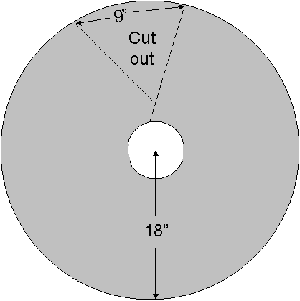 |
|---|
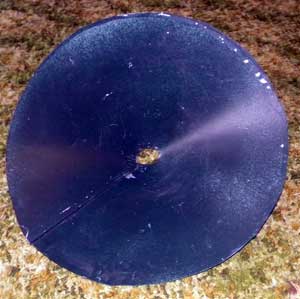 |
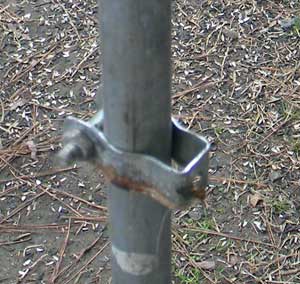 |
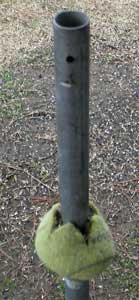 |
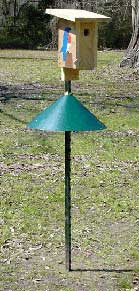 |
Predator guards on posts are essential to protect eggs, nestlings and incubating parents from climbing predators. To be effective against raccoons, a conical baffle (also called a Jensen-Arndt “coolie hat” coon guard) needs to be at least 3 feet in diameter. Note that even this size does not deter large snakes (over five feet long) well. Conical baffles may be harder to make, more expensive, and less effective than a stovepipe baffle, and sharp edges can be a problem around children and during monitoring. Some raccoons learn to get around them. However, they are probably the easiest baffle to put up when a nestbox is mounted on a wooden post.
The Louisiana Bayou Bluebird Society uses an alternative mounting method for the conical baffle. It is suitable for metal posts (Electrical Conduit or T-posts). It is easier than the traditional Zeleny mounting method as it does not require tabs or wood blocks. Photos above courtesy LBBS (Evelyn Cooper and Kenny Kleinpeter)
Materials: (note: tractor disc blades also work well, and can be found at farm auctions.)
- 24 or 26 gauge galvanized sheet metal (which won’t rust), 3 feet x 3 feet (can also be made with sturdy hardware cloth, but beware sharp edges)
- 1 tennis ball (used is fine)
- 1 conduit bracket/hanger iron (don’t buy a flimsy one)
- 1/4″ round head stove bolts or small, pan-head sheet metal screws
- Tin snips
- Hardened drill bits (for holes)
- Paint (if desired, to cut down on heat reflectivity and for aesthetics.
Instructions: (also see alternative installation using tabs and wooden blocks.)
- Cut a 3 foot square piece of 24 or 26 gauge galvanized sheet metal. (You can get three guards out of a 3×8 foot piece of metal – see drawing below from Zeleny’s book.)
- The cut out circles.
- Zeleny’s traditional conical baffle was made with a circle that will be 18″ from the center of the circle to the edge (i.e., 36″ in diameter when flat – when formed into a cone the finished diameter will be less). LBBS typically uses a smaller circle (12″ from center to edge).
- You can make a homemade compass to scribe the metal, using a stick of wood with two sharp nails placed 18″ part, or a piece of string and a magic marker.
- To form a cone, you will need an open triangle that measures 9″ on the bottom.
- To facilitate cutting, follow the numbering sequence. To make the first cut (A-B line) make a slot at A with a cold chisel to
- Include a hole (with tabs if desired) in the center that will be big enough for your post:
- 5″ hole fits 4″ diameter post
- 6″ hole fits 5″ diameter post
- 7″ hole fits 5.5 – 6.5″ diameter post
- 7.25″ hole fits 6″ diameter post
- Attach a conduit bracket to the pole. Tighten.
- Cut a tennis ball in half. Cut an X in the center of the top half. (You can find leftovers at tennis courts)
- Slide the tennis ball over the pole to rest on the bracket.
- Slide the cone down to rest on the tennis ball and bracket. The tennis ball fills any holes or gaps that would allow small snake or mouse to come up the pole trying to reach the box.
- When installing the guard, overlap the cut edge to the dotted line in the drawing below.
- Join the ends with two to four 1/4″ round head stove bolts or use four small, pan-head sheet metal screws to hold it together.
- Paint if desired.
More Information:
- Predator and Problem ID and Solutions (guide)
- Comparing Pros and Cons of Various Predator Guard Styles
- Wobbling Stovepipe and PVC baffle instructions
- The problems associated with mounting boxes on trees
- How to make a Noel Guard
- How to make a Hutchings PVC “coon” guard
- Predator and Problem ID and solutions
- Traditional (Zeleny) mount with tabs and wood blocks
Sources:
- Bluebird: How You Can Help Its Fight for Survival
- Bluebirds (Camp & Cottage Collection, 2. Wildlife)
- Bluebirds Forever
- The Bluebird Monitor’s Guide to Bluebirds and Other Small Cavity Nesters
There is NO Yellow Brick road out there leading these young bluebirds to a “Land of OZ” where these birds can live happily ever after, safe from all tragedy. The reality is that NO matter how many bluebirds you raise in a region there are only so many spots for them to breed in and EVERYDAY the area gets cut down smaller one tree at a time, one cubic yard of cement or asphalt at a time.
– Keith Kridler, Bluebird_L, 2007
